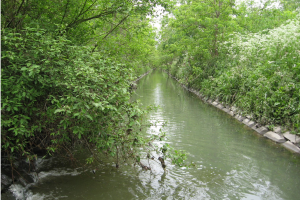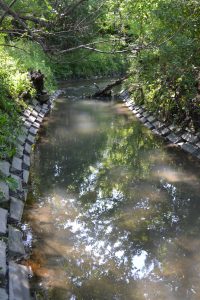
La Pinière stream drains a third of the center portion of Jesus Island and is 7,6 kilometers long. The head of the river is located in the Bois de Boulogne wetlands, then follows Saint-Martin boulevard on the south and crosses Highway 19. A segment of this stream was channeled and redirected on almost 4,5 km where it flows through roads and industrial areas, making it extremely homogeneous in terms of habitat through this section. The stream flows near the Papineau woodland along the railway, then by the Highway 440 on the south, crosses Saint-Vincent-de-Paul’s federal penitentiary and finally gushes into Prairies River by the Jean-Roger-Grégoire riverside.
Seventeen sampling stations were set along the stream. The most upstream station was located near the pit at the intersection of Saint-Martin boulevard and Des Laurentides boulevard. The original segment of La Pinière stream is landlocked in the Papineau woodland. Two survey stations, (LAPI13 and LAPI14) were added to measure the isolating effect in comparison to the reshaped sections of the stream.
Results
Data collected in 2014 allowed to compare this stream with Gascon, la Pinière and Papineau-Lavoie streams.
Fluvial habitat quality
-
La Pinière streams mostly flows through residential and industrial areas.
-
Erosion signs were noted on site LAPI01. Almost all other sites except LAPI02, LAPI13 and LAPI14 have banks which were reinforced by Terrafix or rock fill.

-
This stream stands out by its high speed flow, except for the landlocked segment (LAPI13 and LAPI14).
-
There are 36,7% of its proximity zone occupied by waterproof and sealed surfaces, which is fairly high. Wastewaters of Laval and occasional overflows caused by rainfall and snowmelt are also discharged into the stream.
Water quality
-
Average conductivity was measured at 1673,2 ± 469,4 μs/cm3.
-
Dissolved oxygen levels were measured at 94,6 ± 33%, which is optimal.
-
All the surveying stations had important coliform bacteria levels (E. coli and others) which make it unsuitable for primary contact for the entire summer season. One can therefore not swim in this stream. For secondary contact, some sites were barely on the threshold line by the end of the summer.
-
Average phosphorus levels reveal a potentially concerning water quality.
Biodiversity
Riparian vegetation
-
European buckthorn, common reed, purple loosestrife and reed canary grass are all introduced and invasive species recorded in many sampling stations.
-
No endangered species were observed in this stream.
Benthic macroinvertebrates
- The low diversity of benthic macroinvertebrates can potentially be explained by high levels of organic pollution and a poor water quality. Habitats are also very homogeneous, thus uninteresting for wildlife.
Ichtyological inventories
-
La Pinière stream is very uniform, and so the species richness and general biodiversity are also very low regardless of our enhanced sampling efforts.
-
Young fish, also known as alevins, were observed, which suggests some stream segments and rearing grounds.
-
The most interesting portion of the La Pinière stream is by far the estuary with the Prairies River, which is a known spawning area for fish and a habitat for turtles.
Conclusion and recommendations
Organic pollution is highly problematic in La Pinière stream. The urbanised segments have low biodiversity both due to low species richness and abundance, both in benthic macroinvertebrates and in fish species. La Pinière stream remains an important ecological corridor. In fact, cliff swallows and chimney swallows were observed under a culvert regardless of the high degradation level of this stream. The estuary at the Prairies River has a great wildlife and ecological potential due to the high abundance of aquatic birds and plant colonies useful to fish and turtles. This area is already used and well designed for fishermen.
Report(in French)
Ecological characterization report, 2014: Rapport du projet Ruisseaux urbains de Laval 2014-
Conference (in French)
2014. Le ruisseau Lapinière : entre habitat et égout à ciel ouvert –
Media publication (in French)
March 7, 2016 –
Press releases (in French)
February 17, 2016 –
July 22, 2014 –
.jpg)
Partners and special thanks
Ecological characterization report, 2014
Special thanks
We would like to thank all the stakeholders that contributed to the successful realization of this project. We also thank the ‘’Service aux collectivités’’ and professor Beatrix Beisner’s lab from Université du Québec à Montréal for its amazing collaboration. We wish to highlight their expertise, sampling efforts, species identifications of benthic macroinvertebrates in their labs and for sharing equipment that allowed for the measurement of physicochemical parameters and fecal coliforms of water samples. We would also like to thank the Ministry of Forests, Wildlife and Parks for sharing equipment and knowledge and for the contribution of many specialists during sampling and fish species identifications. We also thank Correctional Service Canada for their contribution in this project by giving us site access for the la Pinière stream located on the federal penitentiary and for their ornithological expertise. CRE de Laval lastly wants to thank the City of Laval, Science Horizons Youth Internship Program, RBC’s ‘’Eau Bleue’’ program and the financial contribution of the Fondation de la Faune du Québec as well as for their shared data and expertise.


(6).png)

